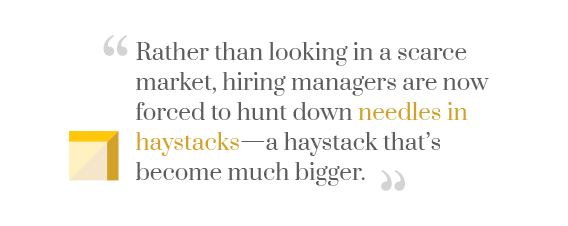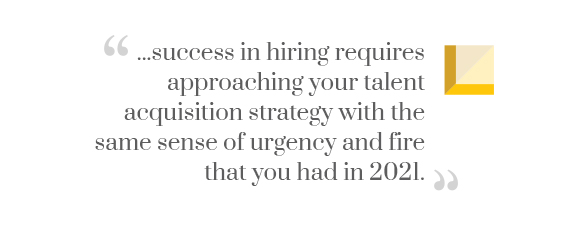Right now, the U.S. job market is, in the words of some experts, “losing steam.” After two years of overheating, things seem to be calming down, or rebalancing, as it were.
But if you’re looking to hire high-quality, specialized talent, you can’t rest on your laurels, sit back, and wait for them to come to you. You have to be out there fighting for each and every placement. Read on to find out why.
From Great Resignation to Great “Rebalancing”
Just two years ago, the headline news was that we were in the middle of a talent shortage. Whether you called it the Great Resignation or Great Reshuffle, the reality was the same: mass resignations and great demands from job seekers meant many companies had trouble landing and retaining quality talent.
Today, the job numbers seem to indicate the opposite trend. According to the Bureau of Labor Statistics, July 2023 saw a decline in job openings, and August saw a slight uptick in unemployment, although nowhere near comparable levels in 2021. These are all telltale signs of a shifting job market—no longer candidate-centric, but employer-centric.

If you only read the surface-level statistics, you’d no doubt come to that conclusion. However, the numbers only tell half the story. Ignore the other half, and you risk making poor hiring & firing decisions that can put your firm at serious risk. Given that we’re experiencing the makings of an economic recession, the risk is greater than ever.
Ask yourself: who is getting laid off?
At Brightwing, we work with some of the leading engineering, IT, automotive, and financial services companies in the Detroit area (not to mention nationwide). Just in the past few months, we’ve heard of thousands of layoffs in the metro Detroit area. However, in conversations with our partners, we’re finding that companies are having more trouble filling critical roles, not less.
To answer this question, you can’t just look at how many people were laid off. You have to ask the deeper question: who is getting laid off?
With every executive and HR department we work with, the answer is resounding across the board. Companies aren’t laying off their top performers. In fact, they’re holding onto that critical talent with an iron fist. Instead, it’s the poor performers that are being let go.
There’s a certain logic to this move. As companies are squeezed for resources, it makes sense to keep the people who, for lack of a better term, deliver the most bang for your buck. Not to mention that quality people are difficult to attract in the best of times, not to mention when times are more difficult.

So although the talent market is flooded with warm bodies, the number of qualified Java developers, embedded systems engineers, data scientists—these haven’t increased all of a sudden. Rather than looking in a scarce market, hiring managers are now forced to hunt down needles in haystacks—a haystack that’s become much bigger.
Changing dynamics in specialized talent acquisition
What’s more, the way to attract top tier talent has evolved, even over the last two years. I’ll give you a case study related to the arms race of electric vehicles in automotive.

Three or four years ago, many leading companies started “e-mobility” groups. Despite unclear objectives and focus, these groups collected talented people to work on the problem of electrification. Now, the critical talent has become even rarer: the coveted EV experts that also are experts in a Tier 1 supplier’s proprietary technology.
Because the intersection of these two skill sets is exceedingly rare, these suppliers are increasingly reliant upon them just to function as a business, much less innovate and grow. Often, the fate of a supplier rests in just one person’s hands.
If one of these engineers decides to leave, often the employer will bend over backwards to retain them. With one company we’re working with, this has led to senior leadership getting involved. It’s not uncommon for companies to offer retention bonuses to this talent. I’ve personally seen an incredible amount of counteroffers for this talent.
This is not the kind of behavior you expect to see in a cooling market. It is the kind of behavior you expect to see in an ongoing shortage of qualified, experienced talent—a shortage that will continue no matter how many low performers get laid off.
The pressure on hiring managers
When it comes to finding top tier talent, high performing companies are actually investing more in talent acquisition, not less. In the automotive industry, for instance, leadership is giving hiring managers an increased budget to make critical hires.

Hiring is an expensive decision in the best of times. But right now, companies have little tolerance for low performers on their teams. The stakes are high, and the risk of a poor hire is greater than ever.
As a result, hiring managers need to work with recruiters that they trust, and who are trusted by top talent in turn. They need to partner with people who’ve taken the time to make inroads with the candidates. This is the only way to mitigate the risk of a bad hire and make the best of increased recruitment spend.
The way forward
The biggest mistake hiring managers can make in this time is to rest on their laurels as the market cools and rebalances. Rather, success in hiring requires approaching your talent acquisition strategy with the same sense of urgency and fire that you had in 2021, when quality talent seemed a dime a dozen. Because, in a sense, it still is.

You need to find candidates that have the right combination of high technical competence plus the intangible skills that make someone successful in your organization. This isn’t rocket science—it just requires hard work, persistence, and the patience to build inroads and generate quality connections.
Hiring managers who execute the fundamentals well will find themselves doing just fine, even if we end up in a recession or economic downturn. Those who make excuses and are unable to adapt will not. Which camp will you be in?
let’s talk
SEND US A MESSAGE


